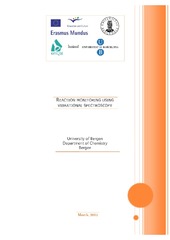Reaction monitoring using vibrational spectroscopy
Master thesis
Permanent lenke
https://hdl.handle.net/1956/17791Utgivelsesdato
2012-03-14Metadata
Vis full innførselSamlinger
- Department of Chemistry [433]
Sammendrag
Reaction monitoring by vibrational spectroscopy (VS), especially NIR spectroscopy, is being increasingly used during process development. Analysts usually use spectroscopy to qualitatively monitor the progress of reactions. Cross-coupling reactions of organic electrophiles and organometallic reagents have increased popularity as a powerful synthetic tool and innumerable improvements have been done from the first protocol that allows a wide range of coupling partners to be combined efficiently1. The aim of cross-coupling reaction is carbon-carbon bond formation. The Suzuki coupling reaction is one of the most efficient methods for the construction of C-C bonds. The objective of the thesis is to monitor a Suzuki coupling reaction by vibrational spectroscopy and to use chemometrics to build the model that can serve to anticipate how far the reaction has proceeded. Our plan is to investigate whether NIR or Raman spectroscopy is better suited for monitoring the reaction. An efficient, versatile and non-destructive method to monitor the reaction by using VS is described. By using this method it is possible to monitor the reaction without interrupting it. In this way time and money are saved. A Suzuki cross-coupling reaction was chosen to be monitored. In this reaction 1-iodo-2-nitrobenzene was used as an organometallic reagent. This reacted with an organic electrophile phenylboronic acid to form 2- nitrobiphenyl as a product. For the occurrence of this reaction the catalyst palladium (II) acetate must be added. A base should be present to promote the transmethyilation process. Potassium carbonate was used as a base. This reaction was monitored by VS under standard conditions which are disclosed elsewhere2. The method allows us to know when the product of interest was formed and to stop the reaction to avoid the formation of contaminations. The recorded data was treated with multivariate data analysis such as PLS (Partial Least Squares) and PCA (Principle Component Analysis). Once a protocol for proper reaction monitoring was developed an experimental design was set up. The purpose of this was to build the model that could serve to predict how far the reaction had proceeded. Temperature, concentrations and reaction time were the variables investigated. The designed experiments were monitored using VS enabling continuous prediction of reaction progress. GC-MS was used to validate the VS prediction results. This necessitated sampling the reaction mixture at predefined intervals for off-line analysis.
